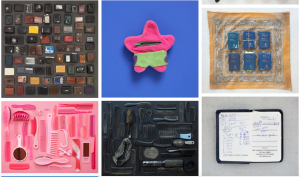Personal objects tell stories about the lives of their owners, sometimes as an intimate diary. They have the faculty to speak about the human condition, in a code that equals us, because it transcends nationalities and passports.
Tom Kieffer, a native of Wichita, Kansas, took note of that connection to make his artwork in Arizona. Because when Border Patrol detains migrants and asylum seekers trying to cross the border into the desert, they also dispossess them of many of their belongings, which they seize and discard.
Kieffer began picking up items that officials threw into the trash at a Customs and Border Protection detention center in southern Arizona, very personal things that authorities considered “potentially lethal” or “non-essential.” For years, Kieffer collected hundreds of these belongings and then photographed them.
In December 2001, three months after the September 11 attack, Kieffer moved to Ajo, Arizona. He had worked in Los Angeles, California, as a graphic designer for more than 20 years. In July 2003, he was offered a part-time job as a janitor at this detention center, very close to his home, David Maris reports for Univision Noticias. Keiffer accepted the job for the good salary and because it would give him enough time for his artistic projects.
He soon learned that this work would be a milestone in his journey as an artist.
It all began with the canned food confiscated from the migrants. As Makeda Easter writes for the Los Angeles Times, during Tom Kieffer’s first two years as a janitor, agents used to donate the food to local food banks, but a change in the leadership of the detention center stopped the donations. Kieffer told the reporter that for the next two years officials threw the food away in the trash.
The janitor then asked for permission to pick it up and donate it. The other objects he also found in the trash shocked him. He began to pick them up.
The first things Keiffer found were different toothbrushes, dozens of them. And he found more and more things. ““When I started seeing a rosary, or a Bible, or a wallet, I realized that no one would believe me if I had not collected these ítems,” Keiffer told Makeda Easter.
He did so for six years, without even thinking that he would photograph this personal effects.
Throughout that time he found water bottles sealed with insulating tape and also canteens, coats, backpacks, dolls, barbies and kens, piggy banks, virgin and christs figurines, passport photos, toothbrushes, bags, rings, cans of tuna, wallets, combs, nail clippers, toothpaste tubes, sunglasses, rubber ducklings, soap bars, condoms, stuffed animals, make-up, shirts, candy and lollipops, shavers, blackened gloves, yarn reels, adult and baby shoes, baby compotes, shoelaces, birth control pills, medication of all kinds, children’s cartoon bags.
Tom Kieffer began photographing the objects he had collected. He would put them together, tidy them, arrange them on a background that would make enough contrast, and then press the shutter
He left his job as a janitor at the detention center in 2014.
The first photographs are about the water containers. Then other photos came with colorful combs on a gray background; or the record collection of a woman named Cynthia; medicines of different types for diarrhea, heartburn, headache or depression; a baby’s unique shoe, male wallets; cans of tuna, sunglasses on top of each other.
Among the most recent photographs there is one of those first toothbrushes he found in the trashcan. Keiffer displayed them all together in such a way as to evoke the United States flag colors (USA! USA! USA! is the name of this his work.)
All these images compose the photographic essay that Kieffer called “El Sueño Americano” –in Spanish–, which is still a work in progress.

Kieffer describes it this way: “El Sueño Americano (the American Dream is a photographic essay of the discarded personal effects and belongings of migrants and smugglers aprehended by Border Patrol agents, discarder while being processed at a U.S. Customs and Border Patrol facility near the U.S./Mexico border in southern Arizona. My intent is to explore the humanity of migrants who risk their lives crossing through the desert and to create a personal connection for the viewer to a migrant and a hope for a better life.”
“I made these images to raise awareness about the treatment of migrants, to show that [the authorities] seize and throw a bible in the trash as if it were a weapon, as if it were something dangerous,” Kieffer told David Maris for Univision Noticias.
On Keiffer’s website, El Sueño Americano begins with a photo of a gallon of water sealed with silver insulating tape, to show that those who cross the desert need at least one container of these a day so as not to become dehydrated on their week-long journey. There are photos with a sketch of an unfinished dinosaur, a love note on a block, a girl’s glove from her quinceañera, belts that are displayed as a spiral maze.
There are more than a hundred photos of this kind. The Skirball cultural center in Los Angeles is exhibiting them from October 17 of this year until March 8, 2020,
In the video presentation for a previous exhibition of El Sueño Americano at the Saugatuck Center for the Arts, Kieffer says: “My work is a snapshot of the things people pack. They come seeking a better life and bring with them what is essential and what is precious.”
The video shows Kieffer reviewing all these objects in his workspace, where he has them classified. “What are the stories in these everyday outfits? What do these item say? What is their story?” he wonders.
Photo: Screenshot from the video presentation of the exhibition of El Sueño Americano at the Saugatuck Center for the Arts
